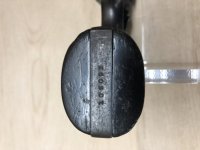I'm considering making an offer on what I think may be a parts gun, even though someone seems to have performed some parts switch-outs somewhere along the line. Current owner has no provenance, nor any backstory and is selling as a legit operable firearm.
I have checked only basic mechanical's, and finish looks real nice blued in that cylinder, barrel, and frame match finish wise with no evidence of hard buffing or dished seams, smooth out pins, which would indicate refinishing.
However with that said (and I cannot remove the grips to see for sure, the following for me are red flags, and the reason I am only considering a buy at parts gun pricing.
The frame and butt have a 4 digit only serial number. There is a lanyard loop and swivel right where the "C" MAY HAVE been if ever. The barrel flat has a 6 digit serial number 383XXX, and the cylinder face has also a six digit serial number 45XXXX. The barrel is roll stamped 32-20 CTG (note: no WCF or Winchester).
The frame is marked on right side Made in USA, the grips are checkered diamond square butt, and with gold washed medallions.
The gun is being sold as a legit firearm and the serial number will be the 4 digit number with no alpha letter. 4 digits do not jive with a Model 1905 4th Change like mine. The 32-20 barrel font appears factory but the font is larger than my 1921, all matching 32-20 WCF.
The big kicker for me is the Made in USA one-liner on right side frame. This should not appear on a true 4 digit 32-20 frame until at least 4th change per SCSW 4th, and would carry at least a 6 digit butt (and yoke) serial number.
Again....none of the serial numbers appear modified or altered in any way, fonts appear factory and age appropriate, however without any provenance I just don't know what to make of it, and will not purchase it, even for parts if the true caliber and age cannot be identified to my satisfaction.
Sorry...........no photos allowed, and I am dealing with an intermediator, not the actual owner.
A couple questions:
Was there ever a cartridge named just 32-20, even black powder that was NOT centerfire?
When did Made in USA, start to appear on (what I assume is a K Frame)?
Would the S&W factory have assembled such a revolver at customer request of a service order after WWII using an older frame, but modern cylinder and barrel of different serial numbers?
Have you ever seen or heard of a 32-20 having a lanyard ring and swivel? Possible miltary/LEO service?
As always thank you in advance for comments, answers and opinions. The "asking" price is $800 but I'm thinking a heck of a lot less for parts only, or pass altogether based on a 4 digit serial number which just does not jive with Made in USA on the frame.
Pics below are my 32-20 WCF, all numbers matching gun that I may take along for comparison IF I even go back.
I have checked only basic mechanical's, and finish looks real nice blued in that cylinder, barrel, and frame match finish wise with no evidence of hard buffing or dished seams, smooth out pins, which would indicate refinishing.
However with that said (and I cannot remove the grips to see for sure, the following for me are red flags, and the reason I am only considering a buy at parts gun pricing.
The frame and butt have a 4 digit only serial number. There is a lanyard loop and swivel right where the "C" MAY HAVE been if ever. The barrel flat has a 6 digit serial number 383XXX, and the cylinder face has also a six digit serial number 45XXXX. The barrel is roll stamped 32-20 CTG (note: no WCF or Winchester).
The frame is marked on right side Made in USA, the grips are checkered diamond square butt, and with gold washed medallions.
The gun is being sold as a legit firearm and the serial number will be the 4 digit number with no alpha letter. 4 digits do not jive with a Model 1905 4th Change like mine. The 32-20 barrel font appears factory but the font is larger than my 1921, all matching 32-20 WCF.
The big kicker for me is the Made in USA one-liner on right side frame. This should not appear on a true 4 digit 32-20 frame until at least 4th change per SCSW 4th, and would carry at least a 6 digit butt (and yoke) serial number.
Again....none of the serial numbers appear modified or altered in any way, fonts appear factory and age appropriate, however without any provenance I just don't know what to make of it, and will not purchase it, even for parts if the true caliber and age cannot be identified to my satisfaction.
Sorry...........no photos allowed, and I am dealing with an intermediator, not the actual owner.
A couple questions:
Was there ever a cartridge named just 32-20, even black powder that was NOT centerfire?
When did Made in USA, start to appear on (what I assume is a K Frame)?
Would the S&W factory have assembled such a revolver at customer request of a service order after WWII using an older frame, but modern cylinder and barrel of different serial numbers?
Have you ever seen or heard of a 32-20 having a lanyard ring and swivel? Possible miltary/LEO service?
As always thank you in advance for comments, answers and opinions. The "asking" price is $800 but I'm thinking a heck of a lot less for parts only, or pass altogether based on a 4 digit serial number which just does not jive with Made in USA on the frame.
Pics below are my 32-20 WCF, all numbers matching gun that I may take along for comparison IF I even go back.
Attachments
Last edited:








